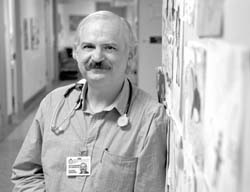Negotiating a cellular cease-fire
by Kevin Hall
 |
Pediatrics professor Dr. Constantin Polychronakos
[ PHOTO: OWEN EGAN ] |
The military calls it "friendly fire." But when soldiers mistakenly attack patriots instead of foreign invaders, there is a sickening senselessness to such casualties. And when friendly fire happens within the body, the results can be literally sickening.
Auto-immune diseases are caused by the cellular equivalent of friendly fire. The immune system produces cells, called T-cells, which are designed to seek and destroy bacteria and viruses.
However, some people produce T-cells that mistakenly attack normal tissue and cause diseases such as diabetes, arthritis, lupus, anemia, multiple sclerosis, and a variety of thyroid disorders. Nobody knows exactly why the immune system makes such mistakes, but in the case of diabetes, McGill scientists recently made a ground-breaking discovery.
Dr. Constantin Polychronakos, of McGill's Department of Pediatrics, and PhD candidate Petros Vafaidus described in last month's issue ofNature Genetics why some people have immune systems that kill normal, insulin-producing cells in the pancreas.
If too many of these cells are killed, then the resulting insulin deficiency must be replenished by daily injections. Otherwise, metabolic derangements can lead to diabetic coma, and even death.
Most people with auto-immune diabetes are diagnosed in childhood. Polychronakos treats 300 diabetic children in his endocrinology clinic at the Montreal Children's Hospital. Even with such a busy clinical schedule, he is an active research scientist--although he admits his research career started relatively late.
"I was 30 years old when I first stepped into a research lab," says Polychronakos. "I had to stay an obligatory three months as part of my endocrinology training- but I liked it so much that I stayed for a year."
Polychronakos's perspective on diabetes research is unique. "What interests me is not why one out of 200 people get diabetes," he says, "it's why the other 199 don't."
In searching for an answer to this question, he was led to study the genetics of insulin production. Two different genes control the production of insulin, say, genes A and B. Everyone inherits one gene from each parent, so the possible gene combinations are: AA, BB, or AB.
Last year, Polychronakos and his colleagues discovered that both genes can produce the same amount of insulin in the pancreas. Therefore, regardless of which gene combination is inherited, the pancreas should make the same amount of insulin.
However, researchers already knew that people who lack gene B--and have two copies of A--are four times more likely to develop auto-immune diabetes.
"Here was an empirical observation, and we wanted to know the mechanism," says Polychronakos. They reasoned that if insulin produced by gene B helps suppress auto-immune diabetes, then this gene must play a role in the immune system's basic training centre, the thymus.
It's in the thymus that the immune system learns to distinguish native cells from foreign invaders. T-cells are activated when they come into contact with proteins called antigens. Each T-cell is randomly programmed to interact with only one kind of antigen. Those that react to proteins naturally found in the body are instructed to commit cellular suicide in the thymus.
Polychronakos explains, "Many insulin-specific T-cells are deleted in the thymus. How are they deleted? You need to have the antigen there."
And there must be enough of it so that the T-cells which cause auto-immune diabetes can be recognized and eliminated. It's precisely for this purpose that the thymus produces a tiny amount of insulin. While both genes A and B can contribute, Vafaidus and Polychronakos found that they do not contribute equally.
Thymic insulin production was studied in aborted, healthy human fetuses. They compared the relative insulin production of each gene and found that gene B--the diabetes-suppressing gene--made two to three times more thymic insulin.
Polychronakos argues that people who don't have gene B--and therefore have lower levels of thymic insulin--are more likely to have T-cells that attack the insulin-producing cells in the pancreas.
This is an exciting discovery, but it accounts for only one step in the progression of the disease.
"One or two T-cells aren't going to do much damage," says Polychronakos, "but when a T-cell encounters its specific antigen [insulin], it multiplies like crazy making clones of itself- -- millions of T-cells which have the same specificity."
When insulin-specific T-cells are activated, they make substances called cytokines. Cloning is promoted by some cytokines and inhibited by others. T-cells that make growth-promoting cytokines are destructive because they increase the size of the T-cell army. Protective T-cells make inhibiting cytokines that slow down the growth of the army.
Although people with the diabetes-suppressing gene probably have fewer insulin-specific T-cells in total, Polychronakos predicts that they also have a higher proportion of protective T-cells. Testing this hypothesis is the present goal of his laboratory, and if proved, it immediately suggests a possible therapy.
"We could clone protective T-cells in the laboratory and inject billions of them into the patient," says Polychronakos. This could halt the proliferation of destructive T-cells and stop the progression of the disease.
Polychronakos's research also has implications for other auto-immune diseases. In multiple sclerosis, for instance, T-cells destroy the insulating myelin that wraps around nerve fibers. One of the two genes that produce the myelin protein was found to suppress multiple sclerosis--similar to gene B's suppression of diabetes. His discovery should prompt researchers to study thymic production of the myelin protein.
"I hope that the competition doesn't think of this too fast," jokes Polychronakos. He finds the similarity intriguing, but like most productive scientists, he keeps a narrow focus. "I'm not interested in multiple sclerosis, but this is an experiment that someone has to do."
Whoever does the experiment, Polychronakos and his team have pointed the way towards a cellular cease-fire.
Kevin Hall is a PhD candidate in physics and a participant in the Reporter's Student Science Writing Internship program. Based on an initiative at the University of Guelph, the program is sponsored by NSERC.